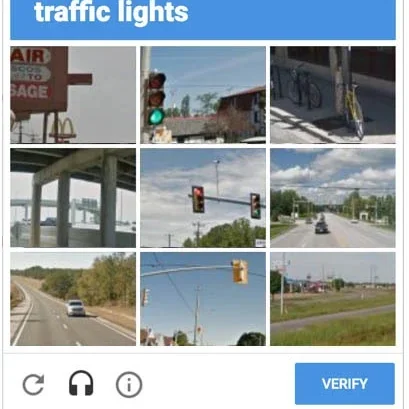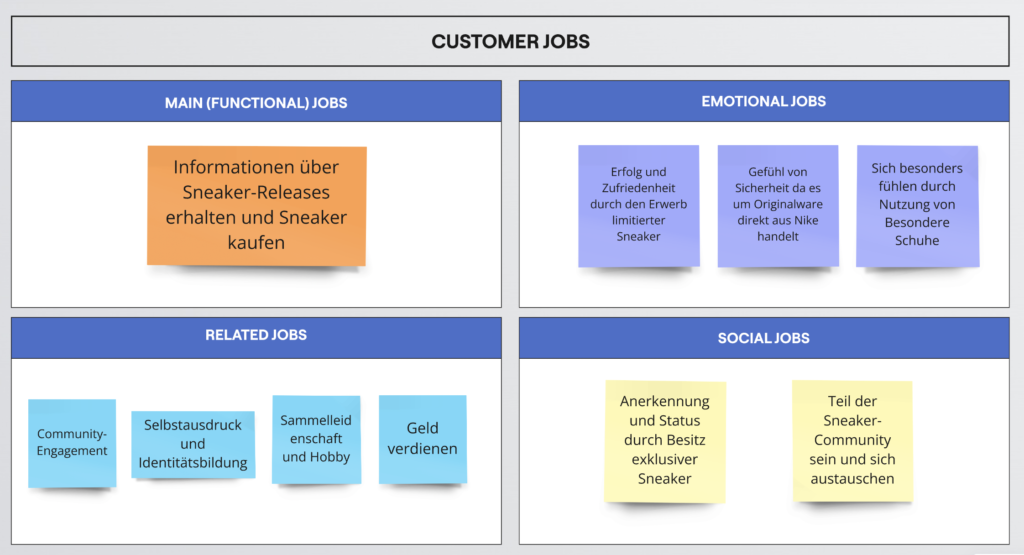Enhancing Nike SNKRS App
Introduction
This is a fictitious case study I conducted to explore the application of the Jobs-to-be-Done (JTBD) framework in improving user experiences. The project focused on the Nike SNKRS App, a popular platform for exclusive sneaker releases. While the scenarios and findings are fictional, they are based on structured research methods and highlight how JTBD principles can guide meaningful product improvements.
Instead of concentrating solely on app features, I used the JTBD framework to address a fundamental question:
“What job are users hiring the SNKRS App to do?”
Product Presentation: Nike SNKRS App
The Nike SNKRS App is a leading platform for sneaker enthusiasts that combines innovation with exclusivity:
- Exclusivity: Access to limited-edition sneaker releases.
- Limited Models: Users can acquire hard-to-find sneakers, enhancing their collections.
- User-Friendly Interface: Simple, clean, and intuitive design for seamless navigation.
- Innovative Features: Lottery systems (Raffles) and exclusive drops for fairer access to sought-after models.
- Established Presence: A dominant player in the sneaker market, trusted by millions.
- Community & Status: Creates a sense of belonging, achievement, and exclusivity within the global sneaker community.


Why JTBD Interviews?
JTBD interviews help uncover the underlying needs and motivations of users that go beyond basic app functionality. This framework allowed me to:
- Understand what specific “jobs” users want the SNKRS App to accomplish.
- Analyze the complete user journey—from the first thought to long-term satisfaction.
- Identify pain points, frustrations, and opportunities for improvement.
- Propose solutions that optimize the user experience, making the app more engaging, efficient, and user-friendly.
Understanding Users
To gain a deeper understanding of the users, I prepared and conducted a detailed user interview based on the JTBD Framework. This structured approach explores the entire user journey and focuses on uncovering deeper motivations and needs.
The interview was organized into key sections:
- Introduction: Understanding the user and their background with the app.
- First Thought: When did the user first feel the need for a better sneaker-buying solution?
- Passive Searching: How did they start considering alternatives?
- Triggering Event & Active Search: What specific events prompted them to actively seek a new solution?
- Decision: Which factors influenced their decision to use the SNKRS App?
- Purchase: What were their expectations and experiences during the buying process?
- Usage: How did their first interactions with the app feel?
- Satisfaction: Did the app meet their expectations? What issues remained unsolved?
- Closing Questions: Would they recommend the app, and under what circumstances might they stop using it?
Job Map
After conducting the user interview, I gained valuable insights into the needs and challenges of SNKRS App users. This step focuses on analyzing the data to identify the concrete “jobs” and desires of the target group, significantly influencing product and marketing strategies.
Key Insights
- Usage of the SNKRS App: Primarily for tracking releases and applying for limited models.
- Mixed Experiences: Positive interactions with less popular models but frustrations with popular ones due to bot activity and Nike+ membership preferences.
- Pain Points: Repetitive PayPal data entry and app crashes during high-demand drops.
- Trust and Preference: Strong preference for official apps like SNKRS due to authenticity and better payment systems.
- Lotteries: Users appreciate the fairness of randomized lotteries.
Struggling Moments
- Perceived unfair advantages for bots and Nike+ members.
- Repeated PayPal data entry causing frustration.
- App crashes and freezes during peak usage.
Context
- Began using SNKRS in 2019 out of curiosity and boredom.
- Frustration with the Nike Store App prompted a switch to SNKRS.
- Active search for better apps to improve the sneaker-buying experience.
Abandoned Alternatives
- Nike Store App: Lacked exclusive models and fairness in releases.
- Zalando: Unavailability of desired sneakers.
- StockX: High resale prices and limited selection.
- Other Sneaker Apps: Explored but failed to deliver unique value compared to SNKRS.
Forces in Progress
This step analyzes the forces that influence user behavior during their transition from one solution to another. By breaking down these forces into Push, Pull, Habits, and Anxieties, we can better understand the dynamics that drive or hinder adoption of the SNKRS App.
Push (Pressure to Leave the Current Product)
- Repeated Failure in Sneaker Releases:
- “After six consecutive releases where I wasn’t selected… I just gave up.”
- Frustration with Bots and Nike+ Memberships:
- “People are being prioritized through additional accounts or Nike+ memberships, plus so many bots.”
- Time Lost Due to Repeated PayPal Data Entry:
- “The PayPal data kept getting erased, so I had to re-enter the address and password every time.”
Pull (Attraction of the New Solution)
- Official Nike App:
- “The SNKRS App is the official app from Nike.”
- Simplified and Faster Payments:
- “The payment process was better… not like in the Nike Store App.”
- Randomized Selection for Sneaker Releases:
- “It only took 15 minutes to participate… you just had to register, and it was a random generator.”
Habits (Existing Habits that Make Switching Difficult)
- Habitual Use of Specific Apps for Sneaker Purchases:
- “I started using the SNKRS App in 2019.”
- Simultaneous Use of Multiple Apps:
- “I kept checking multiple apps at the same time, including Amazon.”
Anxieties (Concerns and Uncertainties about the New Solution)
- App Crashes and Freezes:
- “The app sometimes froze, so I had to close and reopen it.”
This analysis of forces provides a detailed view of what motivates users to switch to the SNKRS App, what keeps them attached to previous solutions, and the barriers they face in fully adopting a new experience.
Customer Jobs
In this step, we delve into the various “jobs” the SNKRS App fulfills for its users. These jobs are categorized into Main Jobs, Emotional Jobs, Related Jobs, and Social Jobs, providing a comprehensive view of user motivations and expectations.
Main (Functional) Jobs
- Staying Informed About New Sneaker Releases:
- “Primarily, I used the SNKRS App to find out about releases, when and which shoes are coming out.”
Emotional Jobs
- Success and Satisfaction Through Acquiring Limited Sneakers:
- “In most drops, I rarely got anything, but when I did, it was usually models that weren’t so popular.”
- Sense of Security From Purchasing Original Products:
- “Knowing that I’ll get my sneakers, can pay quickly, they’ll arrive fast, and the product won’t be damaged upon delivery.”
- Feeling Special Through Exclusive Sneakers:
- “Even if I plan to buy another sneaker soon, I’d still use the SNKRS App.”
Related Jobs
- Community Engagement:
- Users may indirectly seek to connect with like-minded individuals, engage in discussions about new releases, or showcase their sneaker collections on social media.
- Self-Expression and Identity Formation:
- Sneakers are more than just footwear; they are a medium for users to express their personal style and stand out from others.
- Passion for Collecting:
- Sneaker collecting can serve as a hobby, bringing joy and fulfillment through the acquisition of limited-edition sneakers.
- Earning Money:
- “I’ve looked online to see which sneakers are coming out and whether they’re already being sold at resale prices to potentially make money.”
Social Jobs
- Recognition and Status Through Owning Exclusive Sneakers:
- Users utilize the SNKRS App to gain respect and acknowledgment within the sneaker community. Participating in limited releases and showcasing their acquisitions fosters social status.
- Being Part of the Sneaker Community and Engaging With Others:
- “I heard about the app through friends and my social circle.”
This breakdown highlights the multifaceted roles the SNKRS App plays in the lives of its users, from fulfilling functional needs to supporting emotional and social aspirations. Each job reinforces the app’s value as an essential tool for sneaker enthusiasts.
Job Story
The primary job users aim to accomplish with the SNKRS App is finding and purchasing exclusive sneakers. They want to know when new sneaker releases are happening and rely on a trustworthy app to participate in lotteries and drops. This allows them to acquire rare sneakers and expand their collections.
This Job Story encapsulates the core functional and emotional motivations of SNKRS App users, providing a clear lens through which product decisions can be aligned with user needs.
Analysis
The user interviews revealed several critical insights about the Nike SNKRS App and its value to users like Mario. Key findings include:
What Users Value Most:
- Exclusive sneaker releases that cannot be found elsewhere.
- Authenticity, providing confidence in the product’s quality and originality.
Major Frustrations:
- Preferential treatment for Nike+ members during releases.
- Extensive bot usage that reduces fairness in acquiring limited-edition sneakers.
- Repeated entry of PayPal credentials, causing unnecessary delays and frustration.

Recommendations
The insights derived from the user interviews highlight both the strengths and challenges of the Nike SNKRS App. While users value its exclusivity, authenticity, and lottery system, frustrations such as bot interference and repetitive processes hinder the overall experience. To address these challenges and enhance the app’s appeal, the following targeted solutions were developed, focusing on fairness, community engagement, and broader user reach. These recommendations aim to elevate the SNKRS App to new heights in user satisfaction and loyalty.

Community Features
- Build an internal community platform where users can:
- Share opinions, discuss new releases, and showcase outfits.
- Network and connect with other sneaker enthusiasts.
- Benefits:
- Encourages a sense of belonging.
- Increases user interaction and engagement within the app.

Bot Protection and Fairness
- Implement a robust bot prevention system to ensure:
- Equal chances for all users to purchase limited-edition sneakers.
- A fairer shopping experience.
- Benefits:
- Enhances user satisfaction by addressing a significant frustration point.

Influencer and Affiliate Marketing
- Collaborate with influencers to:
- Promote the app and attract new users.
- Build a stronger following among sneaker enthusiasts.
- Benefits:
- Expands the app’s reach.
- Boosts its attractiveness to a broader audience.
These recommendations are designed to address the main user frustrations while enhancing the app’s unique value propositions. By implementing these features, Nike SNKRS can strengthen its position as a leader in the sneaker market and deepen user loyalty.
Conclusion
This project provided a deep dive into the application of the Jobs-to-be-Done (JTBD) framework, enabling me to uncover the underlying motivations, frustrations, and needs of Nike SNKRS App users. By focusing on what users are trying to achieve—whether it’s staying informed about exclusive sneaker releases, feeling part of a community, or expressing their individuality—I was able to align product insights with user expectations.
Through this process, I learned how JTBD helps shift the perspective from product features to the actual “jobs” users hire a product to do. It allowed me to systematically break down user behaviors into functional, emotional, and social jobs, revealing opportunities for improvement that directly impact user satisfaction.
By combining user interviews, job stories, and a detailed analysis of forces influencing behavior, I was able to propose actionable recommendations, such as enhancing fairness, fostering community engagement, and addressing key pain points. This experience solidified my understanding of how to use JTBD as a powerful tool to design user-centric solutions that not only solve problems but also elevate the overall product experience.




